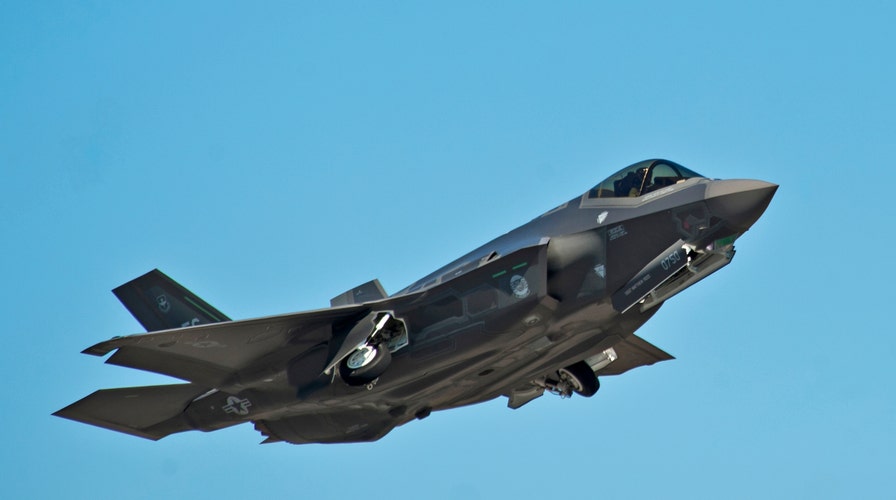Fox News Flash top headlines for January 4
Fox News Flash top headlines are here. Check out what's clicking on Foxnews.com.
It is a vast expanse … an indoor warehouse in Fort Worth, Texas, that almost resembles a small city, filled with row after row of F-35 stealth fighter components and structures at various stages of construction. Stealthy looking, green-colored pieces of fuselage, wires, wings, 25mm guns and partially completed aircraft fill up row after row along a seemingly endless walkway.
The building is home to large, airplane-size workstations in close proximity to one another and populated by workers, experts, engineers and others involved in F-35 creation. The ones showing a box-like lift fan on top of the fuselage are F-35Bs, the ones with the largest wings are F-35Cs and all of the stealthy airframes have a smoothed over rounded area for the aircraft’s 25mm cannon. (I had an opportunity to visit and report on the Fort Worth F-35 production facility several years ago.)
Somehow, the process, which culminates in a green-looking finished aircraft being wheeled into a climate-controlled hangar to receive its grey coat of paint, continued throughout the COVID pandemic. During 2020, F-35 maker Lockheed Martin managed to build 123 F-35As, just slightly below the anticipated pre-COVID number of 141. The 123rd plane for the year, a Lockheed announcement stated, was built at an assembly facility in Italy and delivered to the Italian Air Force.
"In response to COVID-19 related supplier delays, in May the initial annual delivery goal was revised from 141 to 117-123 aircraft to strategically avoid surging, which would increase production-related costs and create future delays and disruption. In 2020, 74 F-35s were delivered to the United States military, 31 to international partner nations and 18 to foreign military sales customers," Lockheed said, in its statement.

File photo - An F-35A Lightning II Joint Strike Fighter takes off on a training sortie at Eglin Air Force Base, Florida in this March 6, 2012 file photo. (REUTERS/U.S. Air Force photo/Randy Gon/Handout)
While of course not all of the F-35s are built in Texas, the facility there offers a window into the complexities likely involved in finding ways to ensure continued production during the COVID pandemic. Workers at facilities can be staggered, tested and instructed to follow strict safety protocols, however, such measures, of course, do not fully eliminate risk.
The biggest challenges to F-35 construction, developers explain, has been ensuring continued productivity and functionality among smaller vendors operating as F-35 suppliers. Many suppliers have smaller facilities, fewer trained experts and fewer employees with which to flex in time of crisis. They also likely have less open, or more dispersed, spaces in which to operate.
"Lockheed Martin took proactive measures to mitigate COVID-19 supplier impacts and position the program for the fastest possible recovery by adjusting employee work schedules, maintaining specialized employee skill sets, and providing accelerated payments to small and vulnerable suppliers. Lockheed Martin provided accelerated payments to more than 400 F-35 suppliers in 45 states and Puerto Rico," another Lockheed statement says.
Lockheed further reports its production infrastructure is on track to meet requirements in coming years, a significant statement given the growing global demand for the F-35.
HOW AI CHANGES ATTACK MISSIONS FOR US FIGHTER JETS AND BOMBERS
As part of the growing international expansion, which includes large Japanese, Israeli and South Korean F-35 buys, among others, the Royal Australian Air Force has just announced its F-35s have now reached initial operating capacity.
CLICK HERE TO GET THE FOX NEWS APP
"Australia currently has a fleet of 33 F-35As, and RAAF crews have surpassed more than 8,780 flight hours to date, with more than 45 pilots and 600 maintainers supporting the fleet," a Lockheed report said. "More than 1,200 pilots and 10,000 maintainers have been trained on the aircraft. Nine nations have F-35s operating from their home soil."
-- Kris Osborn is the managing editor of Warrior Maven and the defense editor of The National Interest --
Kris Osborn is the defense editor for the National Interest. Osborn previously served at the Pentagon as a Highly Qualified Expert with the Office of the Assistant Secretary of the Army—Acquisition, Logistics & Technology. Osborn has also worked as an anchor and on-air military specialist at national TV networks. He has appeared as a guest military expert on Fox News, MSNBC, The Military Channel and The History Channel. He also has a master's degree in comparative literature from Columbia University.

